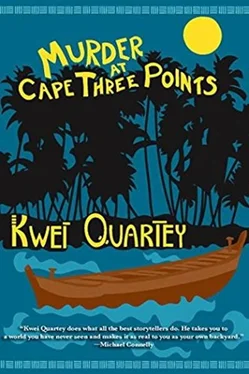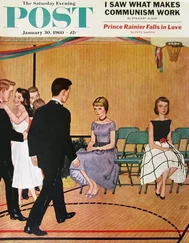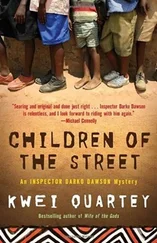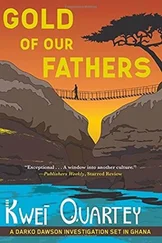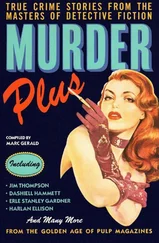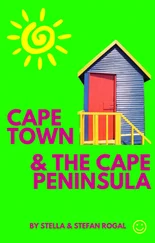He had found it difficult to believe that fishermen would venture out this far in their canoes, but now he saw living proof. There they were, keeping a respectful distance from the rigs. How, he wondered, could the Smith-Aidoos’ murderer possibly have delivered a canoe containing two corpses to the restricted zone around a rig and then disappear without a trace?
The pilot came on the PA system to let them know they’d be landing in five minutes, although Dawson could barely hear him above the background noise. He double-checked his seat belts as they began to descend. For an unnerving second, he visualized the helicopter crashing and the awful aftermath. Unable to grasp his father’s death, Hosiah repeatedly asked Christine, what happened to Daddy?
Dawson shook himself and stopped thinking the worst. Ahead, the Thor Sterke with its angular appendages and spindly lattice crane booms seemed incredibly small and far below them. They were going to overshoot, surely? Dawson couldn’t see how they could possibly touch down on the octagonal-shaped helipad, marked with a large H and perched at the edge of the rig. Could it really hold a helicopter? As they came closer and the helipad loomed, he felt silly. The structure was obviously solid and more than large enough. The helicopter came to a stop in mid-air, hovering over its landing spot for a moment before the pilot set it down with a delicacy Dawson hadn’t anticipated. He heaved a sign of relief. He had made it. He was on a real oil rig after having flown for the first time in his life. And , he thought, all because of murder.
The helicopter rotor blades were still turning as two helipad crew members opened up the compartment beneath the cabin to remove luggage. Then they directed the passengers to the exit staircase directly ahead. To their immediate right was a crane, and another lay ahead to the far left. The derrick was directly in front of them, emblazoned with the name THOR STERKE. In real life and close up, it was massive and towering.
After leaving the helipad, Dawson entered the helilounge in street clothes and emerged transformed in orange coveralls, a green hard hat that marked him as a visitor, regulation steel-toe boots, and safety glasses.
He felt a little strange, but the rig’s culture of safety had impressed him. Indeed, the very first man to welcome him and accompany him on the guided tour was the safety officer. Michael Glagah was as tall as Dawson but of much greater girth. He had a rumbling, resonant voice and was deadly serious about maintaining the rig’s clean safety record. Before anything else, he made sure Dawson knew the location of the lifeboats on the second level, two each at the forward and aft positions.
The sun was warm, but a cool sea breeze softened its intensity.
“Please, can you show me where the canoe with the dead bodies was spotted?” Dawson asked.
Glagah led him to a yellow railing at the edge of an upper level. From there, they could look down to the next tier, a drop of about ten meters. “That’s the pipe deck below us,” Glagah said. “Those long metal pipes you see stacked together on your right are called casing joints. We have to use cranes to lift them and other drilling equipment. So, at the end of the deck there, you see two cranes, one each on the port and starboard side-left and right. You can see how the crane operator has a bird’s eye view. That morning, Clifford was on the starboard side. He saw the canoe coming from the southwest direction, somewhere over there.”
Glagah pointed in a diagonal direction, and Dawson followed his finger. Traveling in an easterly direction, a distant vessel bleak grey in color was moving slowly into view. Dawson made out the name GNS ACHIMOTA along its side.
“Is that one of the naval protection ships?” he asked Glagah, pointing.
“Correct. There are usually one or two of them in the vicinity.”
“How did the canoe carrying Mr. and Mrs. Smith-Aidoos’ bodies escape their detection?”
“One patrol was busy on a mission to intercept some illegal trawlers, while the other one had gone back to shore for a crew change.” Glagah shrugged in regret. “We wish they could be everywhere at the same time, but that isn’t possible.”
“If one or both of the protection vessels had been around, could the canoe have made it into the restricted zone?”
“It would have been very difficult. It was either very lucky, or someone clever engineered its appearance at the right time.”
“How do you mean, Mr. Glagah?”
“A knowledgeable seaman would know in which direction the ocean currents run at a particular time of the day and season,” he replied, looking directly at Dawson, “and therefore when to release the canoe and from what distance. He’d also be familiar with the movements of the patrol vessels. It would take quite a bit of calculation, but it could be done.”
“So,” Dawson said slowly, “an experienced fisherman from any of the coastal communities who is accustomed to coming out this far would fit the grade.”
“Yes,” Glagah confirmed. “He would know how to navigate at night, what maneuvers to watch for from the patrol vessels, and the sea currents.”
Dawson became lost in thought for a while until Glagah interrupted his ponderings.
“Come along,” he said. “Let’s go back to accommodations to change, and then we’ll go to Mr. Findlay’s office.”
Back in regular clothing, they went to George Findlay’s office.
“Good to meet you in person, Mr. Dawson,” he said, shaking hands heartily. “I hope you’ve been enjoying your visit with us?”
“Very much, sir. Mr. Glagah has been a very good host.”
Glagah smiled. “Thank you, Mr. Dawson, and now I’m afraid I must say goodbye.”
Findlay’s office was compact. A quick glance around revealed the artifacts of a long career in the offshore drilling business. A chipped coffee mug with a faded company logo offering to drill deeper cheaper shared dwindling desk space with papers, envelopes, and a computer. Framed pictures of oil rigs and gleaming safety-award plaques adorned one wall.
“Well,” Findlay said, “let’s have a seat, shall we? I was wondering if it would help you to meet Clifford, the crane operator who first sighted the canoe. He’s around if you’d like to talk to him. I let him know you’d be here so we wouldn’t catch him by surprise.”
He crossed to his desk to use the phone. “Hi, John. Can you have Clifford come down? Yes, my office. Thanks.”
They chatted a few minutes until Clifford knocked on the door and entered. In his early thirties, he had a stout build, a diamond stud in his left ear, and jet-black hair. The warm weather outside had flushed his cheeks red.
“Hi, Clifford. Thanks for coming down. This is Inspector Dawson, whom I told you about yesterday.”
“Oh, yeah.” He nodded at Dawson “Hi.” He didn’t appear interested in a handshake.
Findlay stood up. “Take my seat, Cliff. I need to go next door for a minute. I’ll be right back.”
Dawson admired Findlay’s tact. Clifford might not be as forthcoming in the presence of his boss.
“Anything in particular you want to know?” Clifford asked, sitting down as Findlay left. He had a coiled energy, jiggling his right leg up and down in an unconscious, repetitive motion.
“Just the details of that morning when you were working and the canoe with the dead bodies appeared,” Dawson said.
“Well, I was unloading a barge on the starboard side, saw the canoe coming in from the southwest, no one paddling it. I couldn’t pay too much attention at first because I had to concentrate on the unloading, but as it got closer, it just looked strange.”
Dawson had to listen closely to follow what Clifford was saying. His speech was rapid, and he had a thick Scots accent.
Читать дальше
